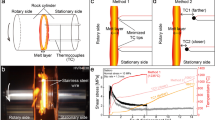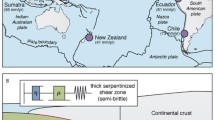Abstract
Laboratory studies of frictional properties of rocks at slip velocities approaching the seismic range (∼0.1–1 m s−1), and at moderate normal stresses (1–10 MPa), have revealed a complex evolution of the dynamic shear strength, with at least two phases of weakening separated by strengthening at the onset of wholesale melting1,2,3,4. The second post-melting weakening phase is governed by viscous properties of the melt layer and is reasonably well understood5,6. The initial phase of extreme weakening, however, remains a subject of much debate. Here we show that the initial weakening of gabbro is associated with the formation of hotspots and macroscopic streaks of melt (‘melt welts’), which partially unload the rest of the slip interface. Melt welts begin to form when the average rate of frictional heating exceeds 0.1–0.4 MW m−2, while the average temperature of the shear zone is well below the solidus (250–450 °C). Similar heterogeneities in stress and temperature are likely to occur on natural fault surfaces during rapid slip, and to be important for earthquake rupture dynamics.





Similar content being viewed by others
References
Tsutsumi, A. & Shimamoto, T. High-velocity frictional properties of gabbro. Geophys. Res. Lett. 24, 699–702 (1997)
Goldsby, D. & Tullis, T. Low frictional strength of quartz rocks at subseismic slip rates. Geophys. Res. Lett. 29, (2002)
Di Toro, G., Goldsby, D. L. & Tullis, T. E. Friction falls towards zero in quartz rock as slip velocity approaches seismic rates. Nature 427, 436–439 (2004)
Hirose, T. & Shimamoto, T. Fractal dimension of molten surfaces as a possible parameter to infer the slip-weakening distance of faults from natural pseudotachylytes. J. Struct. Geol. 25, 1569–1574 (2003)
Fialko, Y. & Khazan, Y. Fusion by earthquake fault friction: Stick or slip? J. Geophys. Res. 110, B12407 (2005)
Nielsen, S., Di Toro, G., Hirose, T. & Shimamoto, T. Frictional melt and seismic slip. J. Geophys. Res. 113, B01308 (2008)
Rice, J. R. Heating and weakening of faults during earthquake slip. J. Geophys. Res. 111, B05311 (2006)
Goldsby, D. & Tullis, T. Flash heating leads to low frictional strength of crustal rocks at earthquake slip rates. Science 334, 216–218 (2011)
Reches, Z. & Lockner, D. A. Fault weakening and earthquake instability by powder lubrication. Nature 467, 452–455 (2010)
Sammis, C., Lockner, D. & Reches, Z. The role of adsorbed water on the friction of a layer of submicron particles. Pure Appl. Geophys. 168, 2325–2334 (2011)
Han, R., Shimamoto, T., Hirose, T., Ree, J.-H. & Ando, J. Ultralow friction of carbonate faults caused by thermal decomposition. Science 316, 878–881 (2007)
Byerlee, J. Friction of rock. Pure Appl. Geophys. 116, 615–626 (1978)
Di Toro, G. et al. Fault lubrication during earthquakes. Nature 471, 494–498 (2011)
Chester, F. M. & Chester, J. S. Ultracataclasite structure and friction processes of the Punchbowl fault, San Andreas system, California. Tectonophysics 295, 199–221 (1998)
Fialko, Y. Temperature fields generated by the elastodynamic propagation of shear cracks in the Earth. J. Geophys. Res. 109, B01303 (2004)
Dow, T. Thermoelastic effects in a thin sliding seal — a review. Wear 59, 31–52 (1980)
Anderson, A. & Knapp, R. Hot spotting in automotive friction systems. Wear 135, 319–337 (1990)
Lee, K. & Barber, J. Frictionally excited thermoelastic instability in automotive disk brakes. J. Tribol. 115, 607–614 (1993)
Bowden, F. B. & Persson, P. A. Deformation heating and melting of solids in high speed friction. Proc. R. Soc. Lond. A 260, 433–458 (1960)
Molinari, A., Estrin, Y. & Mercier, S. Dependence of the coefficient of friction on the sliding conditions in the high velocity range. J. Tribol. 121, 35–41 (1999)
Schedin, E. & Lehtinen, B. Galling mechanisms in lubricated systems: a study of sheet metal forming. Wear 170, 119–130 (1993)
Brune, J. N., Henyey, T. & Roy, R. Heat flow, stress, and rate of slip along San Andreas fault, California. J. Geophys. Res. 74, 3821–3827 (1969)
Lapusta, N., Rice, J. R., Ben-Zion, Y. & Zheng, G. Elastodynamic analysis for slow tectonic loading with spontaneous rupture episodes on faults with rate- and state- dependent friction. J. Geophys. Res. 105, 23765–23789 (2000)
Abaqus/Simulia. v.6.11; available at http://www.3ds.com/products/simulia/overview/ (Dassault Systèmes, 2012)
Acknowledgements
We thank D. Lockner for comments that improved this manuscript. The SIO Marine Science Development Center provided the lathe used in our experiments. This work was supported by NSF (grant EAR-0838255).
Author information
Authors and Affiliations
Contributions
K.M.B. built the apparatus, K.M.B. and Y.F. designed and conducted experiments, Y.F. performed numerical modelling.
Corresponding authors
Ethics declarations
Competing interests
The authors declare no competing financial interests.
Supplementary information
Supplementary Information
This file contains Supplementary Figures 1-9 and Supplementary Tables 1-2. (PDF 3463 kb)
Rights and permissions
About this article
Cite this article
Brown, K., Fialko, Y. ‘Melt welt’ mechanism of extreme weakening of gabbro at seismic slip rates. Nature 488, 638–641 (2012). https://doi.org/10.1038/nature11370
Received:
Accepted:
Published:
Issue Date:
DOI: https://doi.org/10.1038/nature11370
- Springer Nature Limited
This article is cited by
-
Physical state of water controls friction of gabbro-built faults
Nature Communications (2023)
-
Intermittent lab earthquakes in dynamically weakening fault gouge
Nature (2022)
-
Simple shear origin of the cross-faults ruptured in the 2019 Ridgecrest earthquake sequence
Nature Geoscience (2021)
-
Full-field Ultrahigh-speed Quantification of Dynamic Shear Ruptures Using Digital Image Correlation
Experimental Mechanics (2019)
-
Understanding dynamic friction through spontaneously evolving laboratory earthquakes
Nature Communications (2017)





